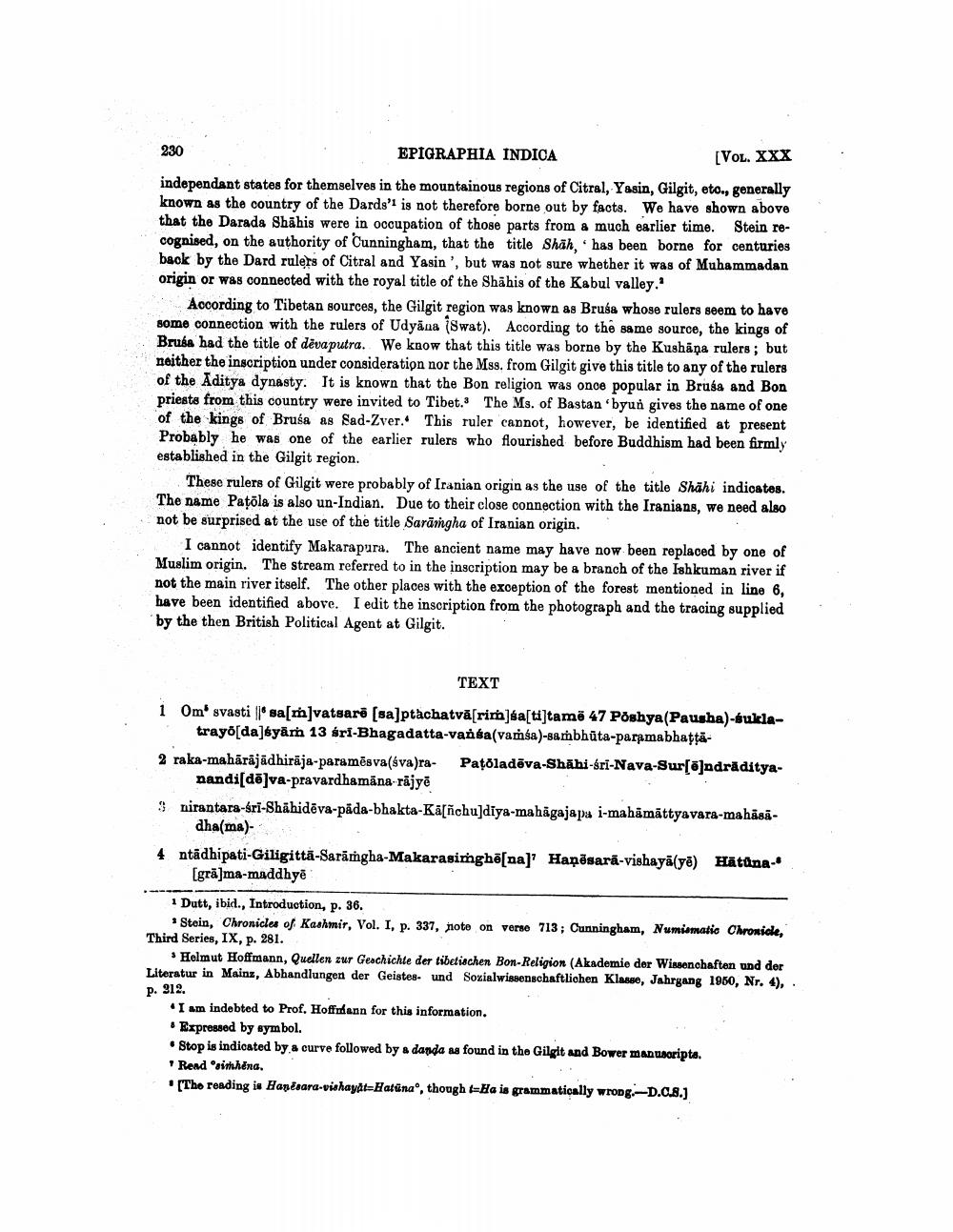________________
230
EPIGRAPHIA INDICA
[VOL. XXX
independant states for themselves in the mountainous regions of Citral, Yasin, Gilgit, eto, generally known as the country of the Dards'! is not therefore borne out by facts. We have shown above that the Darada Shāhis were in occupation of those parts from a much earlier time. Stein recognised, on the authority of Cunningham, that the title Shah, has been borne for centuries back by the Dard rulers of Citral and Yasin', but was not sure whether it was of Muhammadan origin or was connected with the royal title of the Shāhis of the Kabul valley.'
According to Tibetan sources, the Gilgit region was known as Brusa whose rulers seem to have some connection with the rulers of Udyāna (Swat). According to the same source, the kings of Bruss had the title of dēva putra. We know that this title was borne by the Kushāņa rulers; but neither the inscription under consideration nor the Mss. from Gilgit give this title to any of the rulers of the Aditya dynasty. It is known that the Bon religion was once popular in Brusa and Bon priests from this country were invited to Tibet. The Ms. of Bastan byun gives the name of one of the kings of Brusa as Sad-Zver. This ruler cannot, however, be identified at present Probably he was one of the earlier rulers who flourished before Buddhism had been firmly established in the Gilgit region.
These rulers of Gilgit were probably of Iranian origin as the use of the title Shāhi indicates. The name Patola is also un-Indian. Due to their close connection with the Iranians, we need also not be surprised at the use of the title Saräningha of Iranian origin.
I cannot identify Makarapura. The ancient name may have now been replaced by one of Muslim origin. The stream referred to in the inscription may be a branch of the Ishkuman river if not the main river itself. The other places with the exception of the forest mentioned in line 6, have been identified above. I edit the inscription from the photograph and the tracing supplied by the then British Political Agent at Gilgit.
TEXT
1 Om svasti ||*sa[m]vatsare (sa]ptáchatvā[riméa[ti]tami 47 Poshya(Paugha)-sukla
trayo[da]śyām 13 śri-Bhagadatta-vansa(vamsa)-sambhūta-paramabhatta2 raka-mahārājādhirāja-paramēsva(sva)ra- Patoladēva-Shāhi-Sri-Nava-Sur[@]ndrăditya
nandi[dē]va-pravardhamana-rajyo 3 nirantara-sri-Shāhidēva-päda-bhakta-Kā[ñchu]diya-mahāgajapa i-mahämättyavara-mahāsā
dha(ma). 4 ntādhipati-Giligittā-Sarāmgha-Makarasimghē[na)' Hañõsarā-vishayālyē) Hātuna
[grā]ma-maddhye
1 Dutt, ibid., Introduction, p. 36.
Stein, Chronicles of Kashmir, Vol. I, p. 337, note on vorso 713; Cunningham, Numismatic Chronicle, Third Series, IX, p. 281.
Helmut Hoffmann, Quellen zur Geschichte der tibetischen Bon-Religion (Akademie der Winsenchaften und der Literatur in Mainz, Abhandlungen der Geistes- und Sozialwissenschaftlichen Klasse, Jahrgang 1960, Nr. 4), . p. 212.
I am indebted to Prof. Hoffriann for this information. • Expressed by symbol. • Stop is indicated by a curve followed by a danda as found in the Gilgit and Bower manuscripts.
Rend siihena. [The reading in Handsara-vishayât=Hatūna", though t=Ha in grammatically wrong.-D.C.S.)




